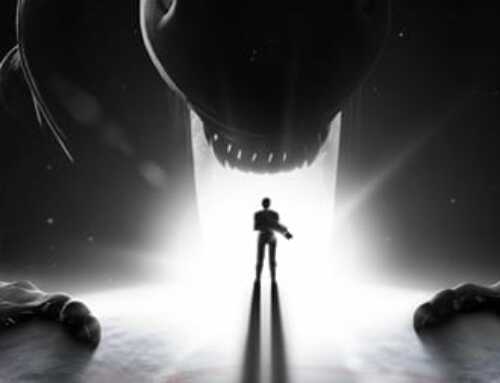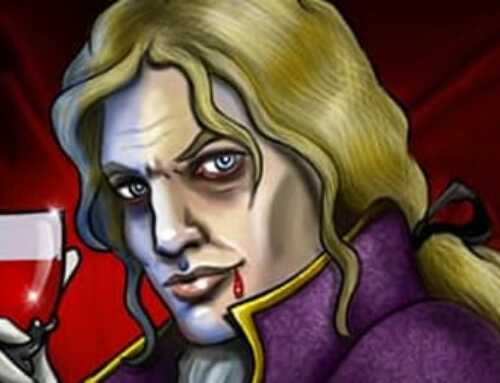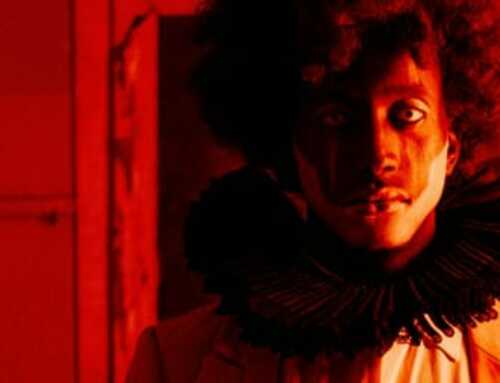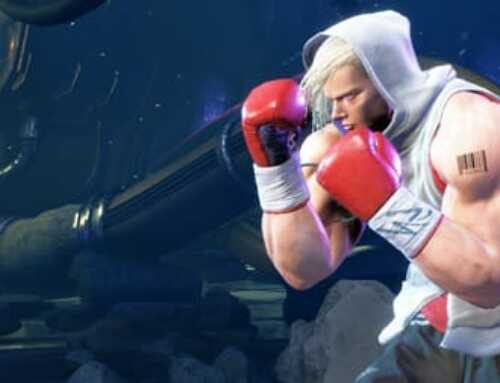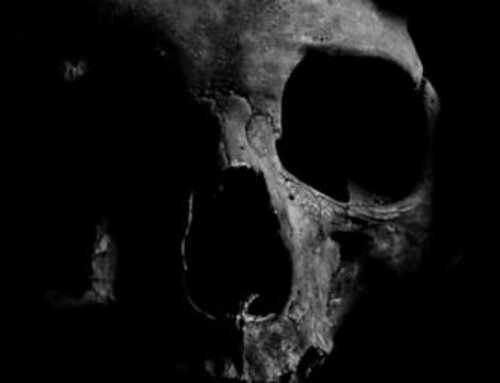It’s no secret that I am a huge fan of indie horror game developer David Szymanski. I’ve previously reviewed his games “Fingerbones”, “The Music Machine”, and “A Wolf In Autumn”. So when Szymanski agreed to do an interview for HorrorBuzz, I thought I’d take the chance to pick his brain about his creative process and his upcoming project “Dusk.” Here’s how that went:
HorrorBuzz: Your games approach horror from a very unique angle, with no jump scares or enemies to be seen. Could you say a bit about your approach to horror, and what made you decide to come at the genre from that angle?
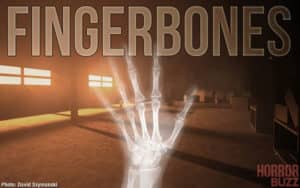 David Szymanski: I think personal taste is a big part of it. I prefer slow-building dread to outright terror. For me, games that try for the “outright terror” approach end up either being really ineffective, or simply unpleasant. With Fingerbones, I wanted to emulate the minimalism of the point and click adventure Scratches, creating horror with as little as possible rather than bombarding the player with tons of hit-or-miss scares. I’m kind of a minimalist at heart, and I see an inherent aesthetic appeal in doing a lot with a little. So for me, it’s preferable to scare the player with a whisper or a word, rather than a screeching monstrosity. And there just aren’t that many horror games like that. Some, but not many. So I figured I’d make one. It’s kind of what’s happened with Dusk. I got tired of waiting for someone to make an authentic throwback to the FPSs of the mid-late 90s, so I’m just making one myself :).
David Szymanski: I think personal taste is a big part of it. I prefer slow-building dread to outright terror. For me, games that try for the “outright terror” approach end up either being really ineffective, or simply unpleasant. With Fingerbones, I wanted to emulate the minimalism of the point and click adventure Scratches, creating horror with as little as possible rather than bombarding the player with tons of hit-or-miss scares. I’m kind of a minimalist at heart, and I see an inherent aesthetic appeal in doing a lot with a little. So for me, it’s preferable to scare the player with a whisper or a word, rather than a screeching monstrosity. And there just aren’t that many horror games like that. Some, but not many. So I figured I’d make one. It’s kind of what’s happened with Dusk. I got tired of waiting for someone to make an authentic throwback to the FPSs of the mid-late 90s, so I’m just making one myself :).
HorrorBuzz: I’ve seen the phrase “walking simulator” used to describe a lot of your games. How do you feel about that term?
David Szymanski: I think the label itself is dumb, but for better or worse it’s definitely something people understand. When you refer to something as a “walking simulator,” most people know exactly what sort of experience they’re going to get. I think my horror games fit in pretty well with other “walking simulators,” so I don’t really mind them being labeled as such. That said, I do kinda wish there a different label that was a little more accurate.
HorrorBuzz: There’s a heavy emphasis on color in your games, whether it’s the washed out colors of “Fingerbones,” the over-saturated colors of “A Wolf In Autumn,” or the stark two-tone coloration of “The Music Machine.” What goes into your choice of a color scheme for a game? What do these colors mean?
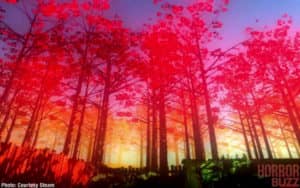 David Szymanski: Well, primarily they mean that I love extreme contrasts between light and dark! In Fingerbones, the extreme desaturation of most areas is supposed to mirror the coldness of the protagonist and the bleakness of his world and outlook on life. The only warmth comes from outside, with bright warm light shining through the windows. But the deeper you get into the bunker and into his head, the darker and bleaker it gets. There wasn’t any real deeper meaning to the colors in The Moon Sliver, other than giving interior areas a sense of claustrophobia and saturation, and giving exteriors a contrasting washed-out windswept feel. The Music Machine’s look was more about communicating an abstract feeling of age and alien-ness (is that even a word?) than any particular subtext (other than at the end, but that’s spoiler territory :D). Finally, A Wolf in Autumn uses extreme saturation to first imply a child-like fantasy world, then the perversion of that fantasy world with sickly colors.
David Szymanski: Well, primarily they mean that I love extreme contrasts between light and dark! In Fingerbones, the extreme desaturation of most areas is supposed to mirror the coldness of the protagonist and the bleakness of his world and outlook on life. The only warmth comes from outside, with bright warm light shining through the windows. But the deeper you get into the bunker and into his head, the darker and bleaker it gets. There wasn’t any real deeper meaning to the colors in The Moon Sliver, other than giving interior areas a sense of claustrophobia and saturation, and giving exteriors a contrasting washed-out windswept feel. The Music Machine’s look was more about communicating an abstract feeling of age and alien-ness (is that even a word?) than any particular subtext (other than at the end, but that’s spoiler territory :D). Finally, A Wolf in Autumn uses extreme saturation to first imply a child-like fantasy world, then the perversion of that fantasy world with sickly colors.
HorrorBuzz: Your games have very simple, blocky objects which tend to contrast with much more dynamically rendered light. Could you talk a bit about the importance of light in your games?
David Szymanski: Simple. I’m good at lighting and bad at modeling :). Ok, I suppose there’s more to it than that. Like I said above, there is a point behind some of the specific lighting/shadowing choices I make. But I concentrate a lot of lighting because it’s something I can do, and I can make up for my weaknesses in other areas with it. That’s all kinda changed with Dusk, though, since I don’t have fancy lighting effects to fall back on. I’ve had to actually buckle down and get better at modeling and texturing.
HorrorBuzz: Could you tell us a bit about your influences?
David Szymanski: For my horror games specifically? David Lynch is a big one. I mean, I actually find his movies a little dull while watching, but there’s something about them that eats into my brain and stick with me long after. Poe is another big influence. Specifically for how he’s able to make things conceptually horrifying, without resorting to extreme brutality or cheap tricks. Lovecraft as well. In terms of writing, I’m a huge fan of William Faulkner, especially for the complexity he gives his characters and the interesting prose. Game-wise, I was very influenced by the game Scratches while working on Fingerbones and The Moon Sliver. I have issues with it as an adventure game, but I was blown away by how it created an atmosphere of genuine dread with very little apart from sinister narrative implications. S.T.A.L.K.E.R: Shadow of Chernobyl and Myst together basically entirely determined my taste in atmosphere. The little audio-visual masterpiece Proteus made me think a lot about how to combine the interaction and presentation of a game into a cohesive whole. The Vanishing of Ethan Carter did a lot to influence the way I look at combining narrative and gameplay interaction.
I mean, I could probably go on for pages talking about games and movies that have influenced me. But in terms of the horror games I’ve made up until now, those are probably the primary ones.
HorrorBuzz: In your opinion, what is the best horror game out there?
David Szymanski: Oh gosh, let’s see…
Well, as far as best game with a horror theme, I’d say the Resident Evil Remake. Every time I play it, I’m just blown away by the design. Every part fits together perfectly. Everything about it has just been fine-tuned perfectly. Even the things people often criticize (the tank controls, the fixed camera, etc) work amazingly well in the context of the game, in my opinion, and just add to the uniqueness of the experience.
As far as best game as a horror game, I’ll go with SOMA. I don’t actually like it very much myself, and I much prefer the “scare philosophy” of games like Scratches, but I can’t deny how masterfully it executes its vision. There are some sequences that are borderline horror perfection. I suppose Amnesia: The Dark Descent deserves recognition as well, although I don’t feel that it’s as well-rounded an experience as SOMA.
HorrorBuzz: “The Music Machine” was something of a sequel to “The Moon Sliver.” Do you plan to more games exploring this particular island and the strange events that happened there?
David Szymanski: I don’t plan on it, per se, but I might. The story I wanted to tell is all there, but some of it is maybe still too obfuscated.
HorrorBuzz: You tend to make rather short games, do you think that you’ll ever try your hand at something a bit longer?
David Szymanski: Absolutely. Dusk is going to be a decent-sized FPS, and most of the ideas I have for future horror games are much longer experiences.
HorrorBuzz: Your games are very narrative-driven and deal with some very heavy themes. Where does your process start? Do you start with a story, then build the game around it? Do you build the story around your idea for the gameplay? Or do you start with a thematic idea and then build both the story and game around that?
 David Szymanski: It depends on the game. Sometimes I go in with a very clear idea of what I want to do, as with A Wolf in Autumn. Other times I don’t have anything, and the story/themes develop gradually as I’m working, as with The Moon Sliver. And sometimes I go in knowing what sort of interaction I want, other times I have to come up with ideas for interaction as I go. Regardless, the first thing I almost always do in Unity is experiment with the visual style. I find it a lot easier to make progress if I have the look of the game down.
David Szymanski: It depends on the game. Sometimes I go in with a very clear idea of what I want to do, as with A Wolf in Autumn. Other times I don’t have anything, and the story/themes develop gradually as I’m working, as with The Moon Sliver. And sometimes I go in knowing what sort of interaction I want, other times I have to come up with ideas for interaction as I go. Regardless, the first thing I almost always do in Unity is experiment with the visual style. I find it a lot easier to make progress if I have the look of the game down.
HorrorBuzz: You tend to make your games entirely on your own. Do you think you’ll ever make a game with a team of other people?
David Szymanski: I won’t say no, but for the time being I plan on working on my own.
HorrorBuzz: “Dusk,” the game that you’re currently developing, seems to be a step in a very different direction after the Unity-based horror games you’ve done over the last year or two. What prompted this change of direction?
David Szymanski: I was feeling kind of burnt out after finishing A Wolf in Autumn. Like I was banging my head against a wall. I think I’d just developed/released too many games too fast, and the stress and emotional ups and downs of going from brute force development cycle to release back to brute force development cycle then release again etc was finally getting to me. So I decided to take a break from game development. Or at least that sort of game development. I just focused on messing with pet projects and brainstorming for future games, and figured I’d pursue a project when it felt like it was going somewhere. One day I decided to model a low-poly Quake-style shotgun and put it on a first person controller in Unity, and Dusk just started developing from there. I’ve always been a huge fan of mid-late 90s FPSs, so from the beginning I knew it was going to be styled that way. But I didn’t expect it to grow as big as it’s gotten. It’s been really nice to work on something that doesn’t fall into the same mold as my previous games. It’s exciting to work again, because I’m trying and learning new things rather than just iterating on stuff I did previously. And Dusk is a game I’ve needed to get out of my system for more than a decade now. Ever since I was 14, I’ve wanted to make a Quake/Doom-style FPS. Now I finally have the time, knowledge, and resources to do it.
HorrorBuzz: Do you have any ideas for what you might work on after you finish “Dusk”?
David Szymanski: Not a clue. I’ve got a ton of projects I’d like to do at some point, but it will depend on what I feel like working on after spending a year or more developing an FPS. Maybe I’ll want to keep going in that direction for awhile longer, with another FPS or some Dusk DLC or something. Maybe I’ll feel like going back to short narrative-driven horror for a bit. Maybe I’ll want to do something I haven’t done before. I’ve wanted to do a game similar to Miasmata for some time now… something with a similar atmosphere, that does focus heavily on mechanics but in a non-traditional way that still compliments the narrative. I’ve got a giant text file of game and story ideas, so like I said it will just depend on how I’m feeling when that time comes.
HorrorBuzz: Finally, the most important horror gaming question: Silent Hill or Resident Evil?
David Szymanski: Well, I have a confession to make. I haven’t played a single Silent Hill game for myself (something which I plan on changing some day soon). I mean, I’ve watched playthroughs of 1, 2, Shattered Memories, 4, Homecoming, and Downpour, and bits and pieces of the others, so I do have knowledge of the games. But I haven’t actually interacted with them, and so I haven’t gotten the full experience.
With that in mind…
As I said above, I think the Resident Evil Remake is absolutely incredible as a game. As horror, I think it’s… fine, I guess. It’s about the tension of limited resources more than genuine fright. And I think that extends to most of the pre-4 titles in the series. And from 4 onward they were more about combat stress than anything else. Silent Hill–particularly 2–is a lot more insidious and unsettling. It doesn’t seem like it plays as well, but even in a video there’s something genuinely uncomfortable about it. So for gameplay, Resident Evil. For atmosphere and horror, Silent Hill.
So there you have it, the man in his own words. I didn’t think that it would really be possible but this interview gave me an even deeper respect for both Szymanski as a designer, and his works. He is currently working on a retro FPS titled “Dusk.” There is not currently a release date set, but I for one am looking forward to it.


